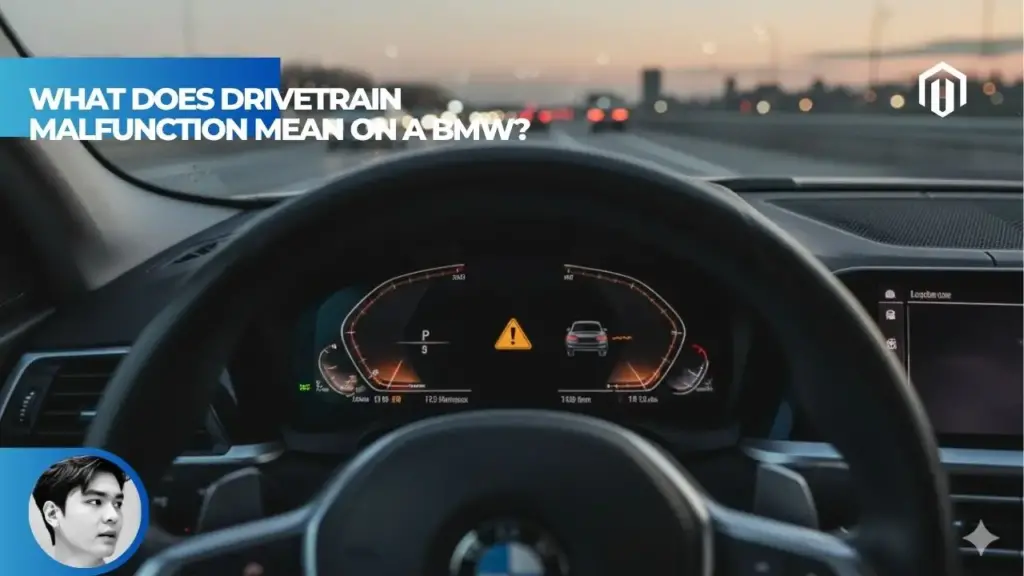You may also like:
- 【Explained】How to Fix an Audi Drive System Malfunction? A Step-by-Step Diagnostic Guide
- 【Explained】What Mileage Do BMW Start to Break Down? High-Mileage Costs and Lifespan
- 【Explained】Can You Continue Driving with an Audi Transmission Malfunction? Decoding the Dash Messages
- 【Explained】What Is More Reliable: BMW or Mercedes? (Repair Costs)
- 【Explained】What’s the Maintenance Cost for BMW? 10-Year Ownership Averages and Budgeting
A BMW drivetrain malfunction warning indicates that the engine control unit (ECU) or transmission control unit (TCU) has detected a problem within the powertrain system—the components responsible for generating and delivering power to your wheels. This warning triggers “limp mode” to protect your vehicle from damage, limiting power and RPMs while the causes can range from simple $100 fixes like fouled spark plugs or bad fuel to major $5,000+ repairs including transmission replacement or high-pressure fuel pump failure[1].

What Does Drivetrain Malfunction Mean on a BMW?
The drivetrain malfunction warning represents one of BMW’s most common yet misunderstood error messages. According to Autvex’s diagnostic data analysis, this warning appears across all BMW models and generations, creating widespread concern among owners who suddenly experience reduced power and dashboard alerts.
Drivetrain Malfunction Error Meaning
The drivetrain malfunction error serves as a general warning that encompasses any issue affecting power delivery from your engine to the wheels. This includes the engine itself, turbocharger, fuel system, transmission, driveshaft, and all related sensors and control modules[2].
When this warning appears, your BMW’s computer has detected parameters outside normal operating ranges. The system doesn’t specify the exact problem—instead, it stores specific fault codes that require professional scanning to identify the root cause.
The warning typically appears in one of two forms:
- Yellow warning: Indicates moderate concern, allowing continued driving with caution
- Red warning: Signals severe issue requiring immediate attention
BMW Powertrain Problem Warning Explained
Your BMW’s powertrain warning differs from simple engine lights by encompassing the entire power delivery system. The ECU continuously monitors hundreds of sensors throughout the drivetrain, comparing readings against predetermined thresholds[3].
Key monitoring points include:
- Fuel pressure and delivery rates
- Ignition timing and spark quality
- Transmission fluid pressure
- Gear engagement sensors
- Turbocharger boost levels
- Exhaust gas composition
When any parameter falls outside acceptable ranges, the system triggers the drivetrain malfunction warning to prevent catastrophic failure.
Components of BMW Drivetrain System
Understanding the drivetrain components helps identify potential failure points. Modern BMW models feature increasingly complex drivetrains with numerous electronic controls[1].
Primary drivetrain components:
- Engine block and internals: Pistons, connecting rods, crankshaft
- Fuel delivery system: Low and high-pressure pumps, injectors, rails
- Ignition system: Coils, spark plugs, control modules
- Forced induction: Turbocharger or supercharger components
- Transmission: Automatic, manual, or DCT with associated electronics
- Driveshaft and differentials: Power transfer components
- Control modules: ECU, TCU, and various sensor arrays
BMW Limp Mode Warning Connection
Limp mode activates simultaneously with the drivetrain malfunction warning, representing BMW’s protective strategy. This safety feature limits engine output to approximately 30-40% of normal power, preventing further damage while allowing you to reach safety or service[2].
Limp mode characteristics:
- Maximum RPM limited to 2,500-3,000
- Reduced throttle response
- Disabled turbocharger boost
- Locked transmission gear (usually 3rd)
- Deactivated sport/dynamic modes
- Restricted top speed (usually 35-45 mph)
Common Engine and Fuel System Causes
Fuel-related issues account for approximately 40% of drivetrain malfunction warnings, making them the most common culprits according to BMW service data.
Low Fuel Level Drivetrain Malfunction
Surprisingly, running below 1/4 tank can trigger drivetrain malfunction warnings on certain BMW models. The fuel pump requires adequate fuel for cooling and lubrication, and low levels cause pump cavitation and pressure fluctuations[4].
Low fuel symptoms progression:
- Intermittent hesitation during acceleration
- Fuel pump whining noise increases
- Drivetrain malfunction warning appears
- Engine stuttering or stalling
- Complete pump failure if ignored
Cost to resolve: $0-50 (simply refuel immediately)
Bad Spark Plugs or Ignition Coils BMW
Faulty spark plugs and ignition coils represent the second most common cause, particularly on turbocharged models. BMW’s high-performance engines demand precise ignition timing, and any degradation triggers immediate warnings[5].
Ignition component failure rates:
- N54 engines: Coils fail every 40,000-60,000 miles
- N55 engines: Improved but still problematic at 60,000+ miles
- B58 engines: More reliable, typically 80,000+ miles
Repair costs:
- Spark plugs: $200-400 (parts and labor)
- Ignition coils: $300-600 per set
- Both combined: $500-1,000
Faulty Fuel Injector BMW Issues
Direct injection systems in modern BMWs operate at pressures exceeding 2,000 PSI, making injectors prone to carbon buildup and electrical failures. A single faulty injector disrupts the entire combustion process[6].
Injector failure symptoms include:
- Rough idle especially when cold
- Misfires under load
- Increased fuel consumption
- Black smoke from exhaust
- Fault codes 30BA/30BB
Replacement costs: $150-300 per injector plus $200-400 labor
High Pressure Fuel Pump (HPFP) Failure
The HPFP remains BMW’s most notorious failure point, especially on N54 and N55 engines. Using proper fuel quality helps prevent premature failure[6].
HPFP failure statistics:
- Average failure mileage: 60,000-80,000 miles
- Failure rate on early N54: Up to 30%
- Replacement cost: $1,000-1,500
- Labor time: 2-3 hours
BMW issued multiple recalls and extended warranties for HPFP issues, though many vehicles remain affected outside coverage periods.
Bad Tank of Gas Drivetrain Malfunction
Contaminated fuel causes immediate drivetrain warnings as modern BMWs require 91+ octane fuel meeting strict quality standards. Water contamination, incorrect octane, or diesel contamination in gasoline vehicles triggers protective modes[1].
Resolution steps:
- Stop driving immediately
- Have vehicle towed to service
- Drain contaminated fuel: $200-400
- Replace fuel filter: $150-250
- Clean fuel system: $300-500
- Total cost: $650-1,150
Mechanical and Electrical Causes
Beyond fuel system issues, mechanical and electrical problems frequently trigger drivetrain malfunction warnings.
Turbo/Charge Pipe Crack Drivetrain Malfunction
Turbocharged BMWs develop boost leaks from cracked charge pipes, particularly the plastic pipes on N54/N55 engines. Even small cracks cause significant power loss and immediate warnings[3].
Common failure points:
- Charge pipe connections: 40,000-60,000 miles
- Intercooler hoses: 60,000-80,000 miles
- Throttle body boot: 80,000-100,000 miles
Repair costs:
- OEM replacement: $400-600
- Upgraded aluminum pipes: $600-900
- Labor: $200-400
VANOS Solenoid Valve Failure Codes
BMW’s VANOS variable valve timing system relies on solenoid valves that frequently fail, triggering fault code 2EF7 and drivetrain warnings. This affects most BMW engines manufactured between 2004-2017[7].
VANOS failure symptoms:
- Loss of low-end torque
- Rough idle
- Poor fuel economy
- Rattling noise from engine
- Reduced power above 3,000 RPM
Replacement cost: $400-800 including diagnosis and labor
Low Battery Drivetrain Malfunction
A failing battery below 12.4 volts causes voltage fluctuations that trigger false drivetrain warnings. BMWs are particularly sensitive to voltage variations due to numerous electronic modules[2].
Battery-related issues:
- Original BMW batteries last 4-6 years
- AGM batteries required on most models
- Coding required after replacement
- Cost: $300-500 including registration
Oil Filter Housing Gasket Leak Drivetrain Malfunction
Oil leaks from the filter housing gasket affect N52/N54/N55 engines, allowing oil to contaminate electrical components and trigger warnings. This issue typically appears around 60,000-80,000 miles[4].
Repair details:
- Parts cost: $50-100
- Labor intensive: 4-6 hours
- Total cost: $600-1,000
- Prevents future electrical damage
Engine Computer Fault Detection
The ECU itself can fail, particularly on models affected by BMW’s technical service bulletins for internal component degradation. Fault codes 30BA and 30BB often indicate ECU hardware failures[7].
ECU failure indicators:
- Multiple unrelated fault codes
- Intermittent electrical issues
- No-start conditions
- Random warning lights
ECU replacement cost: $1,500-2,500 including programming

How to Fix Drivetrain Malfunction BMW
Addressing drivetrain malfunctions requires systematic diagnosis before attempting repairs. According to Autvex’s repair data, proper diagnosis saves an average of $800 in unnecessary part replacements.
Drivetrain Malfunction Warning Reset Procedure
While temporary resets are possible, they don’t address underlying issues. The warning will return until the root cause is resolved[8].
Temporary reset method:
- Turn off engine completely
- Remove key from ignition
- Wait 30 seconds minimum
- Open and close driver door
- Restart engine
- Warning may clear temporarily
Important: This only works for minor glitches—serious issues require proper repair.
Scanning for BMW Fault Codes (OBD2)
Professional scanning reveals specific fault codes essential for accurate diagnosis. Generic OBD2 scanners often miss BMW-specific codes[5].
Common drivetrain fault codes:
- 29E0/29E1: Fuel mixture control
- 30BA/30BB: Injector circuit failure
- 2EF7: VANOS solenoid
- 2C58: Charge pressure control
- 3100: Boost pressure sensor
Professional scan cost: $100-200 at independent shops
Safely Driving with Drivetrain Malfunction
If the warning appears while driving, immediate action prevents further damage. Understanding BMW reliability patterns helps assess urgency[1].
Safe driving protocol:
- Reduce speed to under 45 mph
- Avoid highway driving
- Use hazard lights if necessary
- Find safe location to stop
- Avoid hard acceleration
- Drive directly to service facility
- Maximum distance: 10-15 miles
Drivetrain Malfunction Drive Moderately Guidelines
The “drive moderately” message indicates the system detected a non-critical issue allowing continued operation with restrictions[3].
Moderate driving parameters:
- Maximum speed: 55 mph
- Gentle acceleration only
- Avoid steep hills
- No towing or heavy loads
- Service within 50 miles
- Monitor temperature gauge closely
Cost to Fix BMW Drivetrain Malfunction
Repair costs vary dramatically based on the underlying cause, making accurate diagnosis crucial for budget planning.
Most Common and Cheapest Causes
Based on repair frequency data, these issues represent 60% of all drivetrain malfunctions with relatively affordable fixes[1]:
| Issue | Frequency | Cost Range | DIY Possible |
|---|---|---|---|
| Low fuel | 15% | $0-50 | Yes |
| Bad gas | 8% | $200-400 | No |
| Spark plugs | 12% | $200-400 | Yes |
| Ignition coils | 10% | $300-600 | Yes |
| Battery | 8% | $300-500 | Partial |
| Air filter | 7% | $50-150 | Yes |
Replace Transmission After Drivetrain Malfunction
Transmission failure represents the worst-case scenario, though it accounts for only 5-8% of drivetrain warnings. Similar issues affect Audi models[9].
Transmission repair costs:
- Solenoid replacement: $650-1,000
- Valve body repair: $1,500-2,500
- Transmission rebuild: $3,000-6,000
- Complete replacement: $8,000-12,000
Warning signs of transmission involvement:
- Harsh shifting or slipping
- Delayed engagement
- Burning smell
- Fluid leaks
- Grinding noises
Average Repair Cost Ranges
Professional repair cost analysis reveals distinct pricing tiers based on component failure[1]:
Minor Repairs ($100-500):
- Sensors and switches
- Filters and fluids
- Minor electrical issues
- Software updates
Moderate Repairs ($500-2,500):
- Fuel pumps and injectors
- Ignition systems
- VANOS solenoids
- Turbo components
- ECU repairs
Major Repairs ($2,500-12,000):
- Transmission rebuild/replacement
- Engine internals
- Complete turbo replacement
- Multiple system failures
Model-Specific Drivetrain Issues
Different BMW models exhibit unique drivetrain malfunction patterns based on engine type and generation.
Drivetrain Malfunction on BMW X5 G05
The latest G05 X5 platform experiences specific issues related to its mild hybrid system and complex electronics[4].
Common G05 X5 issues:
- 48V mild hybrid system faults
- Transfer case problems (xDrive models)
- B58 engine injector issues
- ZF 8-speed software glitches
Typical repair costs: $800-2,500
F30 Drivetrain Malfunction N55
The F30 3 Series with N55 engine remains particularly prone to drivetrain warnings between 60,000-100,000 miles[6].
F30-specific problems:
- Charge pipe failure: 95% occurrence rate
- VANOS solenoid: 70% failure rate
- Valve cover gasket: 60% leak rate
- Electric water pump: 50% failure rate
Preventive maintenance cost: $2,000-3,000 at 60,000 miles
Drivetrain Malfunction Intermittent Problems
Intermittent warnings prove most frustrating, often indicating failing sensors or loose connections. These require patient diagnosis through data logging[7].
Common intermittent causes:
- Corroded ground connections
- Failing wheel speed sensors
- Loose wiring harnesses
- Temperature-sensitive components
- Marginal battery voltage
Diagnostic approach requires: 2-4 hours labor at $150-200/hour
Drivetrain Malfunction Red Warning Light vs Yellow
The warning color indicates severity level, with red requiring immediate attention[2]:
Yellow Warning:
- Continue driving with caution
- Schedule service soon
- Monitor for changes
- Avoid aggressive driving
Red Warning:
- Stop driving immediately
- Risk of severe damage
- Tow to service required
- Do not restart engine

Key Takeaways
- Drivetrain malfunction covers entire powertrain from engine to wheels, not specific components
- 40% of cases involve simple fuel/ignition issues costing $100-600 to repair
- HPFP failure remains common on N54/N55 engines at $1,000-1,500 replacement cost
- Limp mode protects against damage limiting power to 30-40% with 2,500 RPM maximum
- Professional scanning essential as generic OBD2 readers miss BMW-specific codes
- Red warnings require immediate stop while yellow allows moderate driving to service
- Transmission issues rare but expensive at only 5-8% of cases but $3,000-12,000 repairs
Decision Path / Next Steps
For Active Warning (Yellow): Drive immediately to your nearest BMW specialist or independent shop specializing in German vehicles, avoiding speeds over 45 mph. Schedule diagnostic scanning within 24 hours to identify specific fault codes. Budget $100-200 for diagnosis plus $300-1,500 for likely repairs based on symptoms. Consider vehicle age and mileage when deciding between OEM and aftermarket parts.
For Active Warning (Red): Stop driving immediately and arrange towing to prevent catastrophic damage. Do not attempt restarting the engine multiple times. Contact your BMW dealer if under warranty or extended coverage. Prepare for potentially significant repairs ranging from $1,000-5,000 based on severity.
For Intermittent Warnings: Document when warnings occur (cold starts, acceleration, specific speeds) to aid diagnosis. Perform basic maintenance including air filter, spark plugs, and battery testing. Consider preventive replacement of known failure points like charge pipes on N54/N55 engines. Budget for extended diagnostic time at 2-4 hours labor.
For High-Mileage BMWs (80,000+ miles): Evaluate whether preventive maintenance might avoid future drivetrain warnings. Replace HPFP, VANOS solenoids, and ignition components preemptively on N54/N55 engines. Consider extended warranty if available and cost-effective versus expected repairs. Maintain detailed service records to support resale value despite repair history.
FAQs
Is it safe to drive my BMW with the Drivetrain Malfunction warning on?
Drive moderately to nearest dealer/shop. Limp mode prevents damage but avoid highway speeds and hard acceleration.
How serious is the BMW Drivetrain Malfunction message?
Severity varies from minor (bad fuel, spark plugs) to major (transmission failure). Diagnostic scanning determines actual risk level.
How can I get rid of the Drivetrain Malfunction warning myself?
Try restarting engine to temporarily reset. Long-term fix requires addressing root cause via OBD2 scanning and repairs.
What are the most common and cheapest causes of the Drivetrain Malfunction error?
Low fuel, bad gas, faulty spark plugs/coils ($50-300). These represent 40% of cases versus expensive transmission issues.
Does Drivetrain Malfunction mean my BMW transmission is broken?
Not necessarily. Often caused by engine/fuel issues, not transmission. Fault codes determine if transmission involvement exists.
Will the Drivetrain Malfunction light go away after restarting the car?
May temporarily disappear but fault codes remain stored. Warning typically returns until underlying issue is resolved.
How much does it cost to fix the Drivetrain Malfunction on a BMW?
$100-500 for minor issues (spark plugs, sensors), $1,000-3,000 for major components (HPFP, turbo), $5,000+ for transmission.
Can a bad battery cause a Drivetrain Malfunction warning?
Yes, low battery voltage causes electrical fluctuations triggering false warnings. Replace battery if below 12.4 volts.
What specific fault codes trigger the BMW Drivetrain Malfunction message?
Common codes: 29E0 (fuel pressure), 30BA (ignition), 2EF7 (VANOS), 2C58 (charge pipe). OBD2 scanning reveals specific codes.
What is the difference between a yellow and red Drivetrain Malfunction warning?
Yellow allows moderate driving to service. Red indicates severe issue requiring immediate stop to prevent catastrophic damage.
References
- Tech Plus Automotive. (2025). Cost to Fix Drivetrain Malfunction BMW. https://techplusautomotive.com/cost-to-fix-drivetrain-malfunction-bmw/
- BW Performance. (2024). BMW Drivetrain Malfunction: Causes and Repair Strategies. https://bwperformance.com/bmw-drivetrain-malfunction-causes-and-repair-strategies/
- Kolben Auto Care. (2025). How to Lower BMW Drivetrain Malfunction Repair Cost. https://kolbenautocare.com/bmw-drivetrain-malfunction-repair-cost/
- Poudre Sports Car. (2024). BMW Drivetrain Malfunction Error: Causes & Solutions. https://poudresportscar.com/bmw-drivetrain-malfunction-error/
- Lafayette German Car Repair. (2024). BMW Drivetrain Malfunction: What Is It and How to Fix It. https://www.lafayettegermancarrepair.com/bmw-drivetrain-malfunction/
- BMW Tuning. (2024). BMW N54 High Pressure Fuel Pump Failure. https://bmwtuning.co/bmw-n54-high-pressure-fuel-pump-failure/
- YouTube. (2023). BMW E90 Misfire – 30BA and 30BB BMW Codes Fixed. https://www.youtube.com/watch?v=jF9atOqq3Mc
- BimmerTech. (2024). BMW Drivetrain Malfunction Warning Reset. https://www.bimmer-tech.net/blog/item/223-bmw-drivetrain-malfunction-warning-reset
- Bimmer-Mag. (2024). Average Cost to Fix a BMW Drivetrain Malfunction. https://www.bimmer-mag.com/cost-to-fix-a-bmw-drivetrain-malfunction/

I am a senior automotive analyst at Autvex. Expert vehicle evaluations, in-depth reviews, and objective analysis helping readers make informed automotive decisions with years of industry experience.








